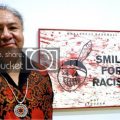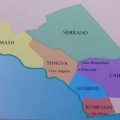When on October 9th the US Supreme Court refused to hear a challenge to a 2103 North Dakota voter ID law disenfranchising thousands of voters living on reservations, I felt compelled to act. Regardless of party, all Americans should agree everyone has the right to vote.
In 2012 North Dakota elected Democratic US Senator Heidi Heitkamp by a mere 2,994-vote margin. Voters on Native American reservations helped her win. In 2013, the Republican-led North Dakota legislature sponsored a law requiring an ID with a residential street address to vote. Before that voters simply showed up and voted. Because most reservation residents only had PO Box numbers, the legislation had the laser-like effect of deterring them from voting.
I reached out to the North Dakota Democratic Party to volunteer as an election day observer on a North Dakota reservation as a member of the party’s legal voter protection team. Although they preferred lawyers, they accepted me on the promise that I would undergo training. In the weeks before the election I did homework and took part in training sessions to learn the law and how to respond if voters were turned away due to ID issues. In the end I was assigned to the Standing Rock Reservation south of Bismarck.
During the pre-election weeks, the Native non-profits Four Directions (http://www.fourdirectionsvote.com/) and Native Organizers Alliance (http://nativeorganizing.org/) undertook a Herculean effort to assign street addresses to all eligible Tribal voters and print laminated photo IDs, and Tribes and Tribal youth, including the Turtle Mountain Youth Council, threw themselves into a get out the vote (GOTV) effort (https://www.facebook.com/turtlemountainyouthcouncil/). It was unclear whether all this would work so late in the game.
Four Directions describes its mission powerfully: “In Lakota culture, the Four Directions represent the way of life we Lakota maintain and the circle of life we individuals participate in to better ourselves and our communities. Times have changed since we went to war to fight for our way of life, our treaties, and our Tribal sovereignty. We now protect our communities and our rights by going to the polls to vote.”
I read and reread the newly released voting manual for the State of North Dakota that described the new voter ID requirement: “When a voter appears at the polling location, state law requires the poll clerk to ask the voter to provide identification to verify eligibility. An acceptable form of identification must include the voter’s name, residential address (a PO Box number is not acceptable), and date of birth.” It went on to say: “The purpose for this requirement is not to deter people from voting . . .” You could have fooled me!
On election eve the legal voter protection team for Standing Rock met at the Prairie Knights Casino and Resort in Fort Yates for final instructions. I received my polling place assignment in a town called Porcupine.
At the crack of dawn on election day the team scattered to polling places. The short walk from the casino to the car was punishing as a subfreezing gale whipped up from the prairie through the hilltop parking lot like a weapon. I foolishly attempted to stow my suitcase in the back seat on the windward side of my rental car. The wind was so strong I couldn’t open the door enough to insert my suitcase, so I retreated to the leeward side. Once in the car, I noticed the water bottle I’d left was frozen solid. I’m originally from Montana and thought I was cold-tolerant, but it takes very strong people to live in the North Dakota cold.
On the main road in Porcupine I saw lawn signs reading “Standing Rock Will Vote” and “Heidi Our Voice for Native Americans”. The community center was a modest tan building—clean and bright, with signs of much use over the years.
Inside Kathleen, the election inspector, was preparing materials, readying an optical ballot scanner, making coffee, and phoning young tribal members who had signed up to be election workers but hadn’t yet materialized. I was instructed to sit at a table across the room from the poll workers.
After a number of phone calls and lassoing a young man who happened by, Kathleen filled all the election jobs, and the workers took an oath as required by the state. A chatty woman named Harriet appeared, tasked with creating official tribal ID letters on the spot for anyone who didn’t have a pre-printed ID.
When the polls opened people dribbled in slowly—all with valid IDs. Everyone knew everyone, and many were related. The older women talked about their kids and grandchildren, and the young people looked down at their smart phones.
After an hour only seven people had voted. I submitted the voter count to “the boiler room” in Fargo where a team of lawyers was stationed to deal with any issues and tally voter turnout throughout the day. Only one question arose regarding an expired photo ID. I was able to tell Kathleen that because the voting manual didn’t explicitly say an ID must be current, the lawyers determined an expired ID was fine.
As things were so sleepy in Porcupine, I was instructed to move to the community center in Cannon Ball where voting was brisker. So I drove 39 miles northeast to Cannon Ball.
As I entered Cannon Ball I passed a billboard reading “INDIANS WILL VOTE”. I looked for a building that looked like the community center. I located a likely candidate, a large, red structure with no sign, three entry doors, and a huge parking lot containing a handful of cars. Before parking I stopped and peered through the snow to determine which of three doors to enter. While I was puzzling this out, a press car drove into the lot, stopped behind me, impatiently blowing its horn as if it were possible to block the way in the huge, empty parking lot.
I entered a grander version of the voting space in Porcupine, and things were indeed livelier. I introduced myself to Blossom, the election inspector and the other poll workers, all of whom were women. I joined five other poll observers seated on the far end of the room, two Republican ‘good old boy’ types, two young female law students, and a fellow Democratic Party observer (a lawyer from Bismarck named Sara Vogel, whom I later learned was co-counsel in a lawsuit that resulted in a $680 million settlement for Native American farmers affected by the USDA’s discriminatory lending practices).
The Republican poll watchers were cordial, but seemed not to have a mission except to warm seats and tell stories to each other. Presumably they were present to make sure there were no shenanigans.
Blossom ran a tight ship. Voters streamed in steadily—the polling place was never without voters during my five-hour watch. All but 12 of the 246 voters presented valid IDs, and tribal letter IDs were created on the spot for the 12. The outcome was that no eligible voter was turned away. One woman had moved to Bismarck was thus ineligible to vote on the Reservation as it was no longer her residence.
A high school teacher brought her voting-eligible students and returned later to vote herself. Everyone was serious about voting. I had been concerned that election observers might be greeted with suspicion. Although some voters were curious about why we were there, everyone was welcoming.
In the late afternoon Blossom ran out of the preprinted ballots supplied by the county election auditor, and substituted photocopied ballots that could not be optically scanned, rather manually tallied at the end of the day. Blossom mentioned that she had requested more printed ballots because she predicted a higher-than-average turnout, but the auditor relied on past precedents to estimate the number of ballets needed.
Throughout the day, some 75 people covered the entire reservation in sub-freezing cold and snow to get out the vote.
A half minute before the polls closed at 7 PM the last voter, an elderly man, entered the hall sheepishly explaining he had fallen asleep.
The Bismarck Tribune reported that evening: “Unofficial results Tuesday night showed 1,444 people voted in Sioux County. The previous record was in 2016 with 1,257 votes.” According to Blossom, voter turnout was almost four times higher at Cannon Ball than the last mid-term election, and she had never seen so many people vote. She had never run out of ballots. It turned out that Porcupine also ran out of ballots.
Based on my observations voting was smooth and professional. All who wanted to vote, voted. Kudos to those who made history in North Dakota on election day—I am privileged to have been there to witness and support it!
From my first-hand observations, the North Dakota Republican Party’s voter suppression effort not only failed, it backfired—unwittingly fueling a movement that is sure to influence future election outcomes.
In an act of poetic justice, Randy Boehning, the prime sponsor of the 2013 voter ID law was unseated by Native American Ruth Anna Buffalo.
Sweet!




Leave a Reply